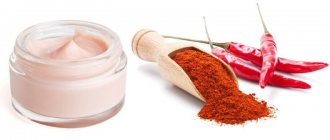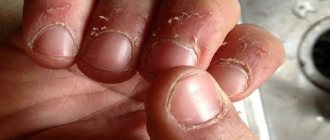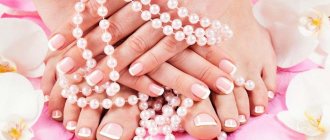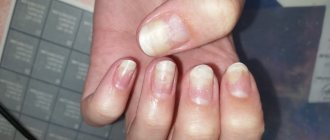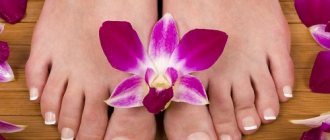Due to exposure to an aggressive environment and daily wear and tear, without proper care, even strong nails eventually become weak, brittle and peeling. Homemade baths to strengthen nails are a simple and affordable way to care for the nail plate and cuticle. Depending on the composition, such baths can not only strengthen, but also solve other nail problems.
How to make nail baths
Homemade nail baths are a full-fledged spa procedure that is easy and simple to do yourself. However, it is important to take into account some nuances and follow the correct procedure. Before immersing your fingertips in the bath, you need to clean the nail plate of any type of coating. Even if there is a medicinal colorless varnish on the nails, it should be removed. Afterwards, rinse your hands with warm water and soap or hand gel. It wouldn’t hurt to get a hygienic manicure and file overgrown nails.
Stores sell special containers for nail baths. If you do not have such a bath, then the procedure can be carried out in a wide and shallow bowl. The main thing is that you can pour a sufficient amount of liquid into it, and then freely plunge your hand into it without spilling anything and arrange your wrist in a comfortable way. Place a terry towel under the bowl, which will prevent the bath from sliding on the surface and you won’t have to worry about drops when you remove your hands from the liquid.
Soak your fingertips in the bath for about 10-15 minutes, then remove your hands, rinse with running water if necessary, and blot your hands with a soft, absorbent cloth. Apply moisturizing cream or nourishing vegetable oil (olive, grape seed, jojoba oil, etc.) using massage movements.
Homemade nail baths are done at least once or twice a week. If the nails are seriously damaged, the procedures are carried out in courses - every other day for 15-20 days, alternating them with oil masks.
Hand care rules
You need to take care of your nails not only by nourishing them, but also by following certain manicure rules. Beautiful, strong and well-groomed nails are what many women want to achieve. Take advantage of our tips on how to enhance the effect of nail baths and maintain the beauty of your hands.
- Rule #1. A manicure is essential! Every self-respecting woman should get a quality manicure at least once every 2 weeks. If you wish, you can learn how to do it at home, rather than visiting a specialist. This will help save time and money.
- Rule No. 2. Never use products that contain acetone to remove old polish. Its aggressive effect will ruin all your efforts immediately, destroying the nail plate from the inside.
- Rule #3 . Give your nails a rest. They need to take a break from the varnish, so it is best to remove it at night.
- Rule #4 . Use only high-quality varnishes from companies you trust. Don't chase low prices to save money. Otherwise, you risk damaging the nail plate very badly, and it will take a lot of time to restore it.
- Rule #5. A manicure file can be glass or ceramic. Forget about using a metal file, it promotes delamination. Also, do not cut your nails with scissors; use a file for this. You can look up how to file properly on the Internet. Manicurists recommend starting from the outer edge and moving towards the middle of the nail on both sides.

After your spa treatment, nourish your hands with a moisturizer
Baths for strengthening nails at home
Homemade baths for strengthening nails can have different compositions. The nail plate mostly consists of keratin, a fibrillar protein that is also a building block for hair. It is keratin that is responsible for the strength of the nail. The elasticity and shine of the nail plates is given by layers of water and fat-like substances. A healthy nail also contains:
- sulfur;
- zinc;
- chromium;
- phosphorus;
- calcium;
- manganese;
- iron;
- selenium.
When choosing ingredients for a nail bath, give preference to those that are rich in the listed beneficial substances, nourish and moisturize the nail, and saturate it with protein. The base of the bath does not have to be water. This could be milk, whey, vegetable oil, fruit or vegetable juice, and even beer. Essential oils are added to the bath not only for aroma. They act as whitening, antifungal, antiseptic agents, accelerate nail growth and are useful in the fight against brittleness and delamination of the nail plate.
Most often, nails peel from a lack of sulfur or due to poor hydration, explains Irina Kulalaeva, a teacher at the Moscow Academy of Nail Art, an international class master. Choosing the right hand care products will help solve this problem.
Causes of brittle nails
But still, what are the reasons for their fragility? A huge influence is exerted by many both internal and external factors.
Internal reasons
- anemia associated with iron deficiency;
- insufficient content of vitamins and microelements in food;
- skin diseases that occur with damage to the nails - fungus, eczema and psoriasis;
- diseases of the stomach and intestines with disorders of absorption and metabolism;
- hormonal disorders during puberty or menopause;
- second half of pregnancy;
- poisoning with salts of heavy metals.
External reasons
- frequent extension and improper removal of artificial nails;
- use of products containing acetone;
- being in conditions of increased dry air;
- direct contact with household chemicals and hot water;
- use of products containing formaldehyde;
- damage to nails: unsparing manicure, compression and bruises of nails, occupational injury when playing musical instruments or working on special equipment.
In addition, there are psychological : prolonged stress or depression, the habit of biting nails. And two clinical diagnoses : onychotillomania - the desire to destroy nails with some tools and onychophagia - nail biting, completely uncontrollable.
To have healthy and beautiful nails, you need not only to eat right and protect your hands when cooking and cleaning, but also to regularly care for them: take baths to strengthen your nails.
Many cosmetic procedures to maintain the beauty and health of the body can be performed at home, for example, making homemade hair masks, body wraps, the Darsonval procedure, making a homemade facial scrub or homemade tonic.
Strengthening nail baths can also be performed at home. By the way, you can also read about baths for nail growth.
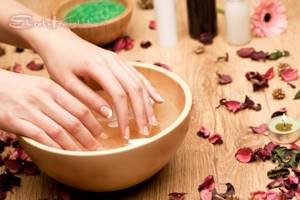
Salt baths for nails
Sea salt is good for brittle, flaky nails. Salt adds shine to the nail plate, strengthens it, promotes hydration and protects against harmful UV radiation. Sea salt owes these properties to its composition, which includes useful minerals - iodine, sodium, magnesium, potassium.
For a sea nail bath, only natural sea salt is suitable, without additives or dyes. You will need one tablespoon of salt for every 200 ml of water. You can add 2-3 drops of lemon or grapefruit essential oil into the saline solution. These oils whiten the nail plate and give it extra shine.
Dissolve the salt in warm water, the temperature of which is not higher than 40°C. If desired, you can add essential oil. Dip your fingertips into the bath and hold for 20 minutes. Rinse with warm water, pat dry with a soft cloth or paper kitchen towel and rub in moisturizing hand cream.
Salt baths for nails can only be done if there are no cracks in the skin of the hands and the cuticle is not injured. Otherwise, choose a different composition.
Why you need to take care of your nails
Baths for rapid nail growth should be performed periodically; this does not require their natural state and structure to be damaged.
Especially during the cold season, girls’ bodies lack vitamins, which affects the condition of hair, nails, and skin. Because of this, you need to change your diet (eat more fruits and grains) and take a course of vitamins. However, for a targeted effect on the problem, vitamins can be used relative to the fingers themselves to make the result more effective and faster.

A neat manicure is always appreciated, but many factors can ruin its natural state:
- Insufficient amount of vitamins in the body, unbalanced diet;
- A long-term infectious disease accompanied by inflammatory processes and decreased immunity;
- Hormonal imbalances;
- Constant contact with water, chemicals and aggressive components, which include alkalis;
- Frequent application of decorative coating. To maintain the health of the plate, it is recommended to periodically take a break, during which it is not recommended to paint your nails.
Nails are the surface covering the sensitive skin of the fingertips, which contain a large number of nerve endings. Because of this, when the protection becomes thin, the fingers become more sensitive and susceptible to aggressive environmental influences.
Nail baths with oils
Vegetable oils are one of the best means for strengthening nails.
They contain saturated fatty acids that moisturize the nail plate, as well as a number of vitamins and minerals. Almond, olive, linseed, castor oil, wheat germ oil and even ordinary sunflower oil are suitable for preparing baths. In addition to omega-3 acids, these oils contain vitamin B7 (biotin), which is involved in the synthesis of keratin, and vitamins E and A, which promote the growth, strengthening and healthy shine of nails. If you slightly heat the oils, they will penetrate inside the nail plate more easily, since the heat causes the keratin scales not to fit so tightly to each other. The nourishing oil solution is also useful for dry cuticles. To whiten the nail plate, add lemon juice to oil baths for nails.
Take one tablespoon of freshly squeezed lemon juice for every three tablespoons of vegetable oil, heat the mixture in a water bath to body temperature and dip your fingertips in it for 15-20 minutes. Lightly pat your hands dry with a paper kitchen towel and rub the remaining oil into the nails and cuticles using light massage movements.
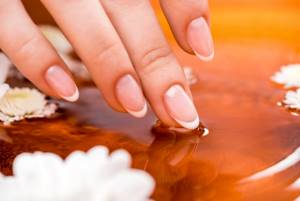
Nails turn yellow and peel. Treatment for peeling nails

Caring for peeling nails is not limited to a hygienic manicure in a beauty salon. It should be comprehensive and include:
- rejection of bad habits
- medical examination to identify internal diseases, their treatment, visit to a dermatologist or mycologist to exclude onychomycosis;
- normalization of daily routine and nutrition (inclusion of vitamin-containing foods in the diet)
- increasing stress resistance
- taking vitamin-mineral complexes
- using gloves when working with cleaning agents and detergents
- Carrying out a course of caring procedures in a nail salon or at home - masks, baths, massage
Advice: Nails Are Peeling What To Do To strengthen the nail plate, you need to purchase vitamins for nails, skin and hair at the pharmacy, and not a general strengthening complex. Special preparations contain exactly the balance of nutrients that are necessary for beautiful and healthy nails.
Nail baths at home: using herbs
Among folk recipes for strengthening, moisturizing and treating peeling nails, one often comes across advice to prepare a bath of herbal decoctions. To soften dry cuticles, moisturize the nail plate, and stimulate nail growth, infusions of mint, chamomile, sage, green tea, and linden inflorescences are suitable. For strengthening, decoctions of plants containing silicas and tannins, such as yarrow, nettle, and oak bark, are suitable.
To prepare a herbal bath for nails, pour boiling water over the dried herbs in a ratio of 1:10, cover with a lid and leave to steep for 30-60 minutes. Strain the finished infusion and warm it slightly. You can also add various oils, vegetable or fruit juice, and milk to it. Try making strengthening nail baths using the following ingredients:
- 1/3 cup olive oil;
- 1 glass of infusion of chamomile and mint;
- 3 drops tea tree essential oil.
Heat olive oil in a water bath, add warm herbal infusion to it and drip essential oil. Stir and dip your fingertips into the prepared bath. Keep them there for at least 15 minutes. In addition to its strengthening and moisturizing effect, this procedure has another bonus - it will help fight nail fungus.
Recommendations from manicurists
A woman with beautiful, well-groomed nails involuntarily attracts attention. It is better to entrust your hands to professionals, however, if you put in the effort, it is quite possible to do your nails yourself. To do this, you should follow some rules:
- When doing manicure, do not forget about baths;
- Avoid cutting the cuticle completely;
- All tools must first be processed;
- To prevent splitting of the nail, the file is held in one direction;
- After healing sessions, gels and varnishes are applied after 2 hours, not earlier;
- The nutrient medium in the bath should be at a comfortable temperature;
- After the procedures, oil or cream is rubbed into the fingertips.
By performing simple but very pleasant procedures, you can have healthy-looking hands and a flawless manicure.
Hot manicure - what is it?
Dry hand skin is a fairly common problem among women. This is due to the constant interaction of the skin with aggressive environmental factors, especially detergents and chemicals. If the top layer of the epidermis is dehydrated and dry, cracks and wrinkles will soon form on it.
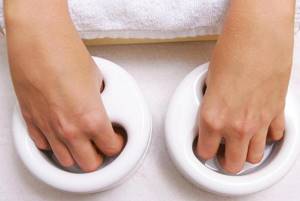
Hot manicure
As a rule, the first thing a woman does is resort to using creams, but they only mask the problem and do not solve it. To greatly enhance the effect, a new procedure was invented in the world of cosmetology - hot manicure. Hot manicure is especially useful in cold weather (winter, late autumn).
A hot (warm) manicure is a cosmetic procedure that moisturizes and therapeutically restores the skin of the hands. Those who visit a beauty salon and get a manicure from a professional master will be asked to dip their hands for a few seconds in a special bath, where oil, cream or nourishing hand lotion has already been heated to 35°C.
This temperature is optimal for activating life processes in skin cells. The heated cream increases blood circulation and opens the pores of the skin, so that the nutrients contained in the lotion penetrate the cells much more actively and quickly. Thus, the heated lotion nourishes and moisturizes the skin many times more effectively than regular lotion.
Note! People who have numerous microdamages to the skin of their hands are contraindicated for hot paraffin baths. Instead, it is recommended to give preference to oil and cream baths.
Benefits of the procedure
Nail baths have many advantages:
- strengthen the nail plate;
- even out the shade of nails and help get rid of yellowness, eliminate light and dark spots;
- help restore nail thickness after extensions or an unsuccessful hardware manicure;
- accelerate the growth of the nail plate;
- restore the structure of the nails, due to which irregularities and grooves disappear from them, a natural shine appears;
- have disinfecting and regenerating properties, help restore hands after an unsuccessfully trimmed manicure.
Despite the fact that nail baths are often recommended as a remedy for nail fungus, their use will not help cope with the disease. The use of baths is justified in combination with medications and should be under the supervision of the attending physician.
Precautionary measures
Despite their simplicity and effectiveness, in some cases, nail baths can lead to deterioration of the condition of the nail plate and skin or cause an allergic reaction. Most often this happens for the following reasons:
Use of components to which there is an individual intolerance. Before carrying out the procedure, it is important to make sure that all herbal ingredients used in preparing the bath do not cause an allergic reaction. This is especially important when using lemon, essential oils and medicinal herbs. Failure to comply with temperature conditions. You cannot use hot water; its optimal temperature should be no higher than 35-40 degrees. If you neglect this condition, you can get a skin burn and ruin the condition of the nail plate. Because under the influence of hot water, nails first expand sharply, and after the bath they narrow just as quickly. All this leads to the formation of microcracks and subsequent detachments.

Excess of active components in solution. In pursuit of quick results, there is a great temptation to use the components of the bath in higher concentrations. But doing this is strictly prohibited. Excess salt will lead to dry nails, and potassium permanganate will cause a chemical burn. Iodine will make the nail plate more brittle, and lemon can corrode the skin of your hands and cause severe pain.
To protect yourself from the troubles described above, it is important not only to strictly follow the recipe, but also not to carry out the procedure for longer than 20 minutes.
When a component does not inspire confidence, then you should refuse to carry out a procedure using it. If there are suspicions that medicinal herbs or a mixture of lemon and honey can provoke an allergic reaction, then it makes sense to conduct a test for intolerance to the components. They are applied to the bend of the elbow and the reaction is observed.
A little history
Hot manicure is very popular nowadays, but it originates from antiquity. Cleopatra herself made hot baths for her hands, adding natural oils and ingredients to the water. In the 16th and 17th centuries, French queens took baths in heated oils, resulting in soft and velvety skin. In the legends about the Greek Gods, there are references to the beautiful hands of the goddess Aphrodite, as well as how she loved to keep her hands in hot rose oil.
Today, hot manicure is very popular and is considered the most elite type of manicure compared to others.
Why do you take baths but there is no result?
Sometimes, all the efforts made do not yield results. Your nails continue to break, remain dull, and you don’t want to look at your hands at all. In this case, there is a reason to pay attention to your health. After all, a lack of certain elements, as well as more serious diseases, often lead to brittle nails.
The first reason why you may have problems with your nails is a lack of calcium. Its deficiency can be corrected through nutrition:
- Dairy products;
- Vegetables of the legume family;
- Nuts and sesame seeds.
Another cause of nail problems is metabolic disorders or diseases of the digestive system. Often, weakness of the nail plate indicates a disruption of the endocrine system. It is worth paying attention to your general health, and if you have other symptoms, consult a doctor.

The first reason why you may have problems with your nails is a lack of calcium.
Another reason may be frequent contact with chemicals during cleaning or due to work needs. It is important to remember here that you should use any detergent only with rubber gloves. This will help maintain not only your nails, but also the elasticity of your hand skin.





